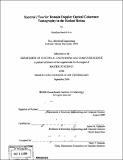Spectral/ Fourier domain Doppler Optical Coherence Tomography in the rodent retina
Author(s)
Liu, Jonathan Jaoshin
DownloadFull printable version (20.69Mb)
Alternative title
Spectral/ Fourier domain Doppler OCT in the rodent retina
Other Contributors
Massachusetts Institute of Technology. Dept. of Electrical Engineering and Computer Science.
Advisor
James G. Fujimoto.
Terms of use
Metadata
Show full item recordAbstract
Optical Coherence Tomography (OCT) is an emerging imaging technique based on low-coherence interferometry for noninvasive, high- resolution, cross-sectional imaging in a variety of biomedical fields. In ophthalmology, OCT has rapidly become a standard clinical diagnostic tool for retinal diseases, providing visualization of the retina with unprecedented detail. However, conventional time domain OCT systems are limited by low imaging speeds. Conventional time domain OCT systems use a mechanically scanned reference mirror to adjust the reference arm path length in time. Spectral / Fourier domain OCT systems use a spectrometer to detect the interference spectrum and do not require mechanical scanning of the reference mirror. This technology significantly improves imaging speed and sensitivity. Spectral / Fourier domain OCT detection methods enable imaging speeds -50-100x faster than conventional time domain OCT systems, providing the capability for three dimensional retinal imaging and blood flow quantification using Doppler OCT measurements. A pre-objective scanning spectral / Fourier domain OCT system for in vivo rodent retinal imaging is designed and built. The system includes a broadband light source to achieve ~-3[mu]m resolution and a CCD camera spectrometer with imaging speed at 25,000 axial scans per second. Applications of spectral / Fourier domain OCT for in vivo rodent retinal imaging are illustrated, including three-dimensional OCT imaging of retinal structure, OCT imaging of the retina preand post-injection, and Doppler OCT imaging providing quantitative measurements of pulsatile blood flow in a retinal vessel. These results demonstrate the ability of spectral / Fourier domain OCT to visualize rodent retinal structure in vivo, perform longitudinal studies by evaluating disease progression in an individual animal, and quantitatively measure rodent retinal blood flow.
Description
Thesis (S.M.)--Massachusetts Institute of Technology, Dept. of Electrical Engineering and Computer Science, 2008. Includes bibliographical references.
Date issued
2008Department
Massachusetts Institute of Technology. Department of Electrical Engineering and Computer SciencePublisher
Massachusetts Institute of Technology
Keywords
Electrical Engineering and Computer Science.